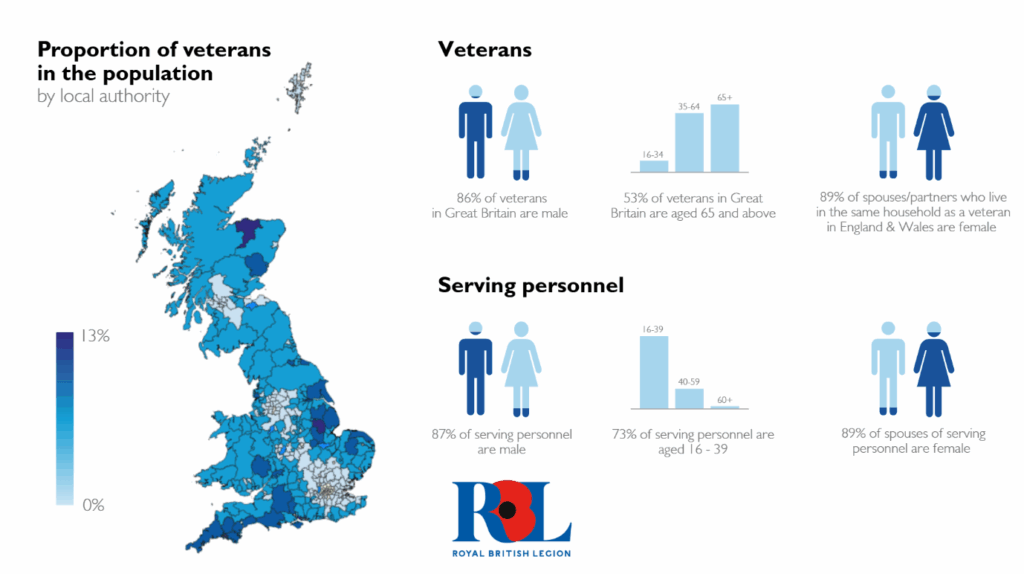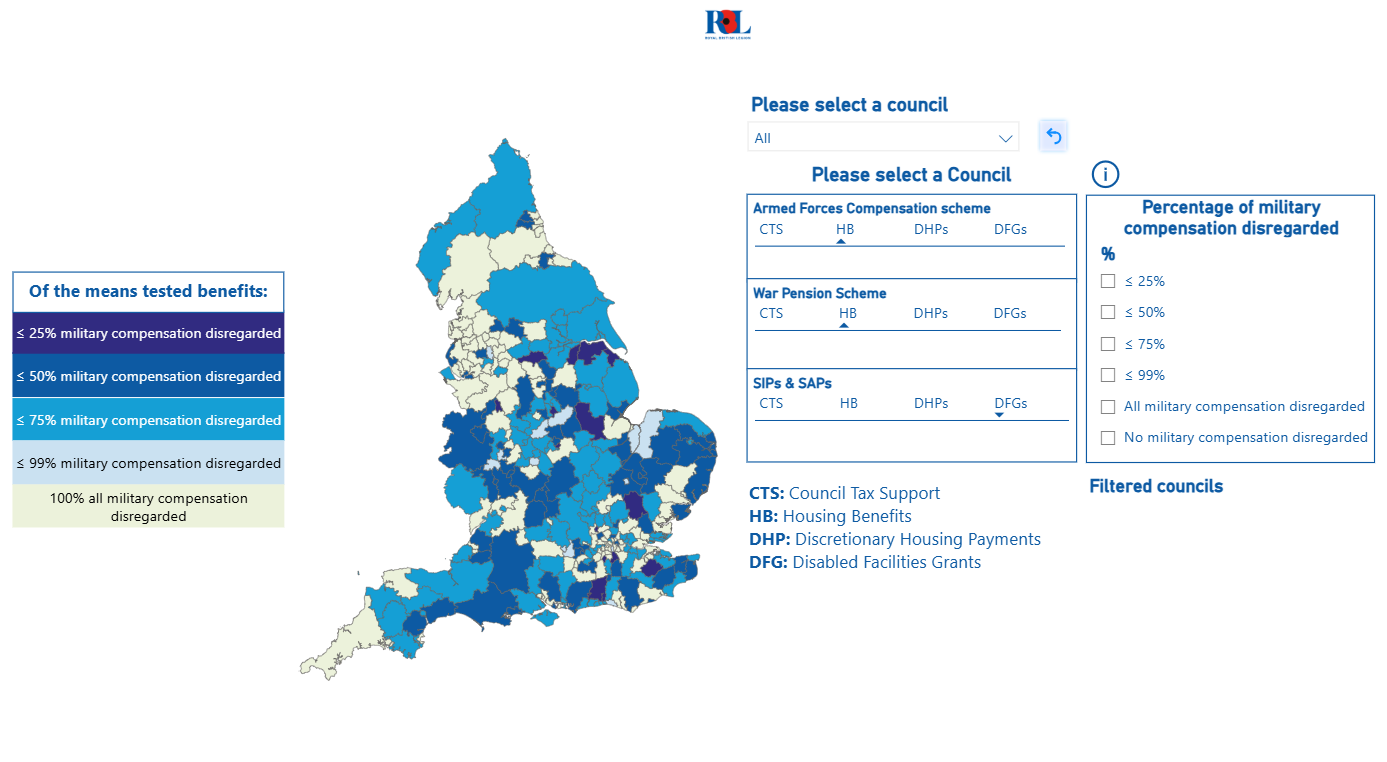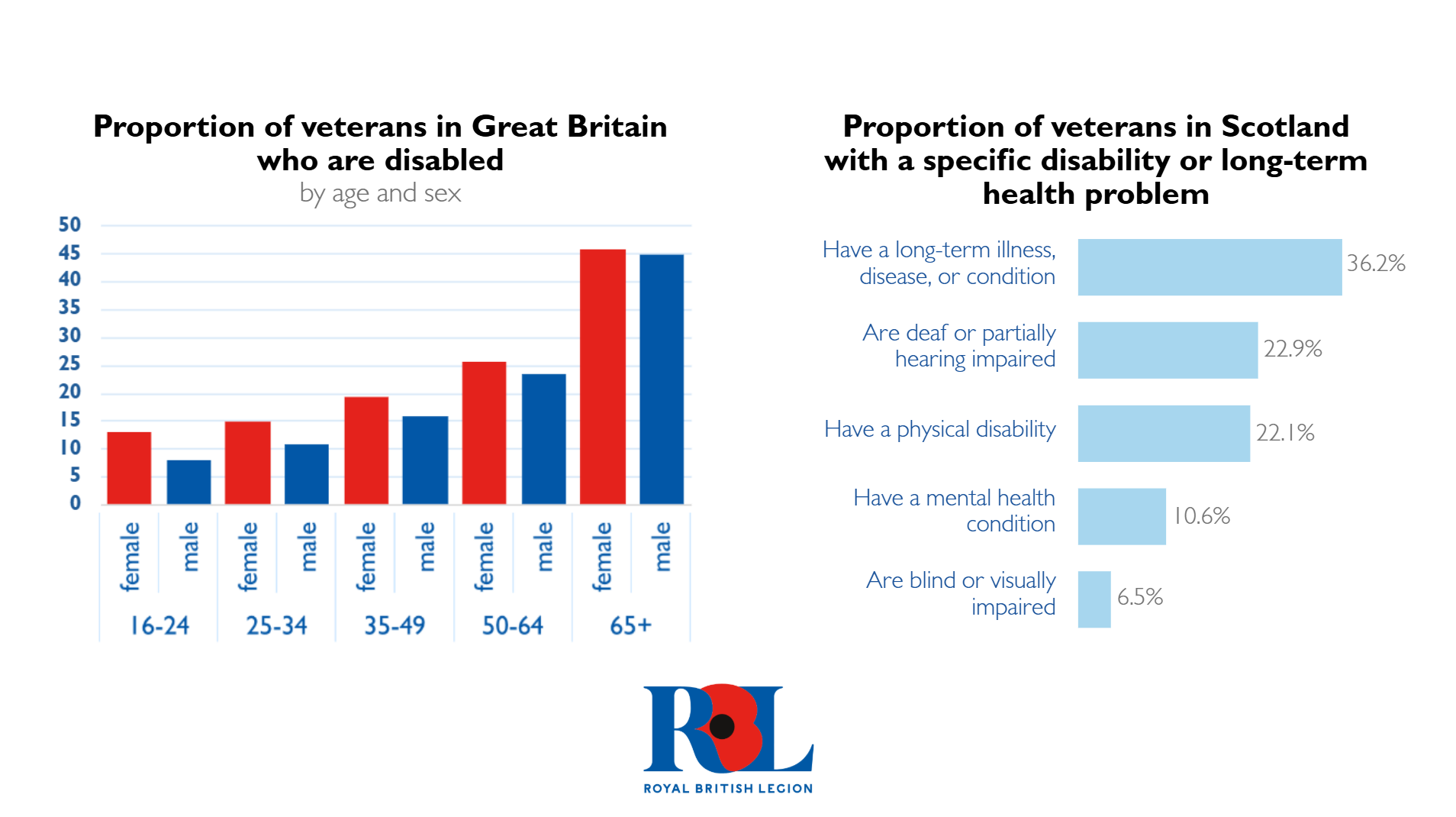

To mark Remembrance Day, Morgan Brown (left) and Heloise Wilson (right) from the Royal British Legion reflect on the impact of Census 2021/22, which for the first time included a question about previously serving in the UK Armed Forces.
To deliver effective support and services, organisations need access to high-quality data about the people that they serve.
When the 2021/22 Census in Great Britain asked, for the first time, whether people had served in the UK Armed Forces, following a campaign by the Royal British Legion (RBL) and Poppyscotland, it filled a long-standing data gap.
For us at RBL, this information has transformed how we support the Armed Forces community (AFC).
These recent advancements in data have provided invaluable insights into this community, now used by local authorities, NHS providers, schools, and charities.
In this post, we’ll share how RBL is using high-quality data on the demographics and needs of the AFC to make a difference – delivering focused support and shaping services that respond to the community’s need.
About Us
The Royal British Legion (RBL) is the UK’s largest Armed Forces charity. We recognise, remember, and support the Armed Forces community, and ensure their unique contribution is not forgotten.
We support serving personnel, veterans, and their families, including the bereaved, across a wide variety of areas, including finance, housing, wellbeing, employment and health, as well as conducting research and running campaigns to ensure that the voices of our community are heard, and their unique contribution remembered.
From data gaps to national insight
Until recent years, there was little reliable data on veterans in the UK.
To address this, we launched our ‘Count Them In’ campaign in 2016. This campaign directly resulted in Census 2021 (England & Wales) and 2022 (Scotland) asking, for the first time, whether someone had previously served in the UK Armed Forces.
Since then, we’ve built a clearer national picture of serving personnel, veterans and their families – who they are, where they are, and what they need. We call this our ‘Needs Analysis’.
What we now know
The UK Armed Forces community – comprised of serving personnel, veterans, and their families – is estimated to make up more than 6.5% of Great Britain’s population.
Census data confirmed there are more than 2 million veterans living in Great Britain, alongside 1.6 million family members living with a veteran in England and Wales. Combining this with Ministry of Defence data, and the best estimates of those living in Northern Ireland, we have determined that there are around 4.5 million people in the UK’s Armed Forces community.
While Scotland has a higher proportion of veterans relative to its population, England and Wales are home to more veterans overall. Most serving personnel and veterans are male, whilst most spouses/partners are female. Serving personnel are largely aged 18–39, and a significant portion of veterans are over 65.
Figure 1: Image from RBL’s Needs Analysis presentation pack and interactive data dashboard showing the proportion of veterans in the population by local authority (left), and gender and age breakdowns of veterans, serving personnel and their spouses (right).
 This image shows a map of Great Britain, with shading to indicate local authorities where the proportions of veterans in the population are highest. This information is sourced from Census 2021/22. Larger version of image / Accessible version of data.
This image shows a map of Great Britain, with shading to indicate local authorities where the proportions of veterans in the population are highest. This information is sourced from Census 2021/22. Larger version of image / Accessible version of data.
The AFC has a distinct demographic profile compared to the general population – understanding this is essential, as it means they may face unique challenges that require tailored support.
The older age profile of veterans, for example, makes disability a common challenge – though veterans are slightly more likely than non-veterans to be disabled, even when age and gender is taken into account. Census data has played a crucial role in identifying these differences, which has given us a clearer view of need in our community.
The Armed Forces community’s needs – and how we can meet them
The Census has been vital in evidencing the needs and disadvantages faced by the Armed Forces community, including in areas of finance, disability, and childcare.
Finance
Census data allowed us to map veteran populations by local authority. The local authorities with the highest proportion of veterans in their general population are Gosport (12.5%), North Kesteven (9.4%), Fareham (9.0%), Moray (9.0%), Plymouth (8.4%), and Wiltshire (7.5%).
Local authority data underpins our ‘Credit Their Service’ campaign, which calls on councils to stop counting military compensation as income in means-tests for welfare benefits.
Military compensation is awarded by the government to approximately 160,000 veterans and their families in recognition of pain, injury, or loss endured in service to the Armed Forces. Yet, in some cases it is still counted as income, reducing or removing eligibility for key benefits, and causing veterans and their families to miss out on thousands of pounds every year.
Thanks to our campaign, more than 50 councils across the UK have already changed their policies, ensuring thousands of veterans injured in service will now receive their compensation and benefits in full.
However, there is still work to be done.
Some local authorities, including those with high proportions of veterans like Gosport and Wiltshire, have yet to make these changes. When influencing key decision-makers in these relevant areas, census data allows us to evidence the size of the veteran population and the need for this change, resulting in tangible benefits.
You can visit our interactive ’Credit Their Service’ map to see if your local authority disregards military compensation as income.
If your council is still treating some military compensation as income, we would love to work with you to address this – please contact us at publicaffairs@britishlegion.org.uk.
Figure 2: Image from RBL’s interactive dashboard showing the progress of our ‘Credit Their Service’ campaign across local authorities.
Disability
In the 2021 Census, veterans living in England and Wales were more likely to report disability (32%) than the general population (30%), even when adjusting for differences in age, sex, and geographic region.
In Census 2022, 22.1% of veterans living in Scotland reported a physical disability, 22.9% reported being deaf or partially hearing impaired, and 10.6% reported a mental health condition.
These findings inform both our policy recommendations and our support services.
We know veterans are more likely to experience musculoskeletal problems or hearing impairment than the wider population, and that frequent relocations can make accessing healthcare difficult for serving personnel and their families.
Accordingly, our policy manifesto highlights the issues that the AFC may face in relation to healthcare, and proposes recommendations for steps that the UK government must take to ensure that the community is supported.
Insights into the health and disability of veterans also evidences the need for RBL’s direct support.
Our recovery courses, which support physical and mental health, supported more than 700 beneficiaries in 2024, alongside the 64 competitors who were selected to be part of Team UK at the Invictus Games 2025.
Similarly, our Admiral Nursing service provides holistic support to the families of those living with dementia, and helps more than two thousand beneficiaries a month on average.
Figure 3: Image from RBL’s Needs Analysis presentation pack showing the proportion of veterans in Great Britain who are disabled (left) and the proportion of veterans in Scotland with a specific disability or long-term health problem (right).
Larger version of image / Accessible version of data.
Caring responsibilities
Analysis of Census data showed that women make up a larger proportion of Reserve veterans (23.8%), compared to those who served as Regulars (11.2%) and those who served in both the Regular and Reserve forces (5.5%).
This may be because of the flexibility offered by Reservist roles, making them more accessible to women who are more likely to take on caring responsibilities for children or other family members.
Census data also shows us that veterans in England and Wales are more likely to provide unpaid care (11.6%) than non-veterans (10.6%). Among spouses/partners of veterans in England and Wales, 18.9% provided unpaid care, as did 8% of children/stepchildren.
RBL briefed Parliament on International Women’s Day, celebrating women in the Armed Forces community, while highlighting their unique needs. In this briefing and in previous policy asks we have supported making Flexible Service more accessible and that women should be able to request this without fear of harming their career prospects.
We are delighted that there has been a shift towards increased acceptance of part-time work of requests for personnel to have reduced separation from their home base over long periods of time.
Looking to the future
Census data doesn’t just describe the present – it helps us plan for what’s next. A major study by RAND, commissioned by RBL, used Census and Ministry of Defence data to project how the AFC’s size and composition may change over time.
These projections guide our strategic planning, and have enabled us to anticipate needs across services and our wider activities. We have also shared insights with the wider sector, to support evidence-based action.
Why is this important?
With these future predictions in mind, it is vital that RBL can track changes in needs and demographics over time. Longitudinal data gives insight into the impact that our work is having and allows us to measure the success of policies such as the Covenant.
The Armed Forces Covenant is a promise that individuals will not experience disadvantage due to Service, and will receive special consideration in cases such as injury or bereavement. In November 2022, the Armed Forces Covenant Duty was introduced – a legal duty on local authorities and certain local public bodies “to have due regard to the principles of the Armed Forces Covenant when exercising certain statutory functions in the fields of healthcare, education and housing.”
RBL has campaigned for expansion to this duty and anticipates change in coming months to ensure it is applied to a much wider range of policy areas and public sector organisations. It is essential that this duty is practically translated into action and is delivered consistently across all nations and relevant policy areas. Looking into the future, data on the demographics and needs of the Armed Forces community is essential.
Looking ahead, RBL are advocating for Census 2031 to retain the veteran question, to provide data on veterans’ household members, and to enable robust comparisons with the non-veteran population. We are also aiming to influence other longitudinal studies and data collected by public bodies, to fill gaps in our understanding of the Armed Forces community.
By ensuring veterans and their families remain visible in future data collections, we can continue identifying needs, driving fairer policy and making sure every member of the AFC gets the support and recognition they deserve.
At the Royal British Legion, we’re always interested in how others are using data to make a difference. If your organisation is exploring new data sources or insights to better understand and support your communities, or you want to find out more about our work, we’d love to connect and share learning.
Please email policyandresearch@britishlegion.org.uk.
About the author
Morgan Brown is a research officer for the Royal British Legion.
As part of the Campaigns, Policy, and Research team at the Royal British Legion, Morgan brings together research and evidence to inform policy recommendations, enhance service provision, and ensure the voices of the Armed Forces community are heard.
Morgan has a background in psychology and behavioural science, and enjoys communicating research and insights for use in policy development and decision-making.
Heloise Wilson is a Royal British Legion Case Officer for Bristol, Somerset and Wiltshire.
In her role as a Case Officer, Heloise ensures that beneficiaries receive appropriate welfare support across areas such as finances, housing, employment, health and wellbeing. This involves carrying out person-centred assessments and detailed analyses of individual circumstances and needs.
Previously, Heloise has contributed to research projects focused on domestic violence and behaviour change, as well as academic work within the field of Psychological Science. She has also contributed to and shadowed the Campaigns, Policy and Research team at The Royal British Legion, helping to inform ongoing research and advocacy work.
Other stories you’ll find interesting
Comment or question about this blog post?
Please email us!


